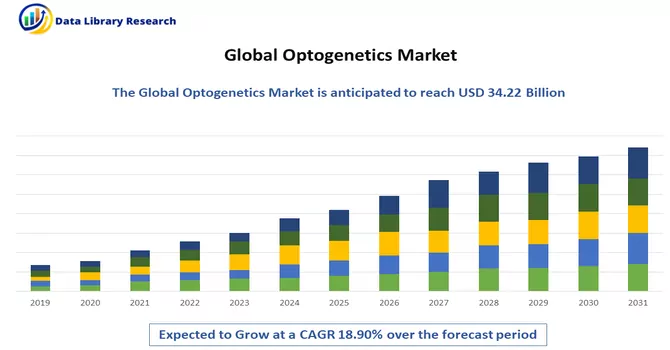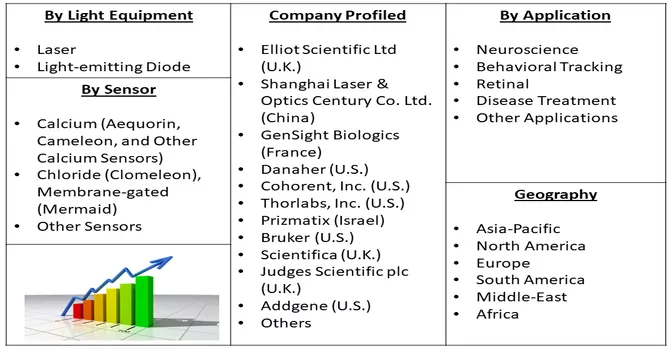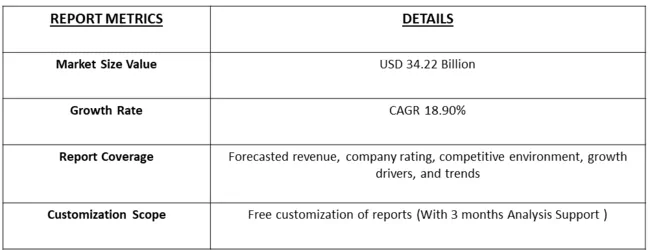The Global Optogenetics market is valued at USD 34.22 Billion in 2024 and is projected to attain a CAGR of 18.90% during the forecast period, 2024–2031.

Get Complete Analysis Of The Report - Download Free Sample PDF
The optogenetics market emerges as a transformative force within the field of neuroscience and biomedical research, offering unprecedented capabilities for precise manipulation and observation of cellular activity. Grounded in the integration of optics and genetics, optogenetics leverages light-sensitive proteins to control and monitor specific cellular functions with remarkable precision. This technology enables researchers to modulate neural activity with spatial and temporal accuracy, facilitating the exploration of complex neural circuits and providing insights into neurological disorders.
The optogenetics market extends its applications beyond neuroscience to areas like cardiology, ophthalmology, and optogenetic therapies. As research continues to uncover the intricate mechanisms of cellular processes, the optogenetics market is poised for sustained growth, playing a pivotal role in advancing our understanding of the nervous system and paving the way for innovative medical interventions.A key growth-driving factor for the optogenetics market lies in its revolutionary impact on neuroscience and biomedical research. Optogenetics uniquely enables precise manipulation and observation of cellular activities by utilizing light-sensitive proteins, allowing researchers to modulate neural activity with unparalleled accuracy. This capability has not only transformed the understanding of complex neural circuits but has also opened new avenues for studying and potentially treating neurological disorders. The versatility of optogenetics extends its applications to various medical fields, including cardiology and ophthalmology, promising innovative therapeutic interventions. As the demand for advanced tools to unravel the complexities of cellular functions increases, optogenetics stands at the forefront, poised to shape the future of neuroscience research and contribute significantly to the development of novel medical solutions.
Market segmentation: Global Optogenetics Market Growth & Companies and it is Segmented by Light Equipment (Laser and Light-emitting Diode), Sensor (Calcium (Aequorin, Cameleon, and Other Calcium Sensors), Chloride (Clomeleon), Membrane-gated (Mermaid), and Other Sensors), Application (Neuroscience, Behavioral Tracking, Retinal, Disease Treatment, and Other Applications), and Geography (North America, Europe, Asia-Pacific, Middle East and Africa, and South America). The market values are provided in terms of USD million for the above segments.

For Detailed Market Segmentation - Download Free Sample PDF
Market trends in optogenetics reflect a dynamic landscape characterized by continuous advancements and expanding applications. One notable trend is the increasing integration of optogenetic tools into neuroscience research, fostering a deeper understanding of neural circuits and paving the way for potential therapeutic interventions in neurological disorders. The technology's versatility is driving its adoption beyond traditional neuroscience applications, with a growing presence in cardiology and ophthalmology research. Moreover, there is a trend towards the development of more user-friendly and efficient optogenetic technologies, streamlining experimental procedures and broadening accessibility for researchers. Collaborations between academia and industry players are on the rise, spurring innovation and accelerating the translation of optogenetics from research tools to potential clinical applications. As the optogenetics market continues to evolve, these trends collectively position it as a transformative force in both basic science and the pursuit of groundbreaking medical interventions.
Market Drivers:
The growing need for precise and sophisticated tools
The growing need for precise and sophisticated tools has emerged as a driving force in various scientific disciplines, particularly in the realm of neuroscience research. As our understanding of complex biological systems deepens, researchers face an increasing demand for innovative technologies that can manipulate and observe cellular activities with unparalleled accuracy. This necessity is particularly evident in neuroscience, where unraveling the intricacies of neural circuits and comprehending neurological disorders require tools capable of pinpoint precision. Optogenetics, with its ability to precisely modulate cellular functions using light-sensitive proteins, has positioned itself as a transformative solution to this growing need. The technology's unique capability to offer unparalleled precision in manipulating neural activity aligns seamlessly with the heightened demand for sophisticated tools, making optogenetics a pivotal driver in advancing the boundaries of neuroscience research and contributing to groundbreaking discoveries in the intricate world of cellular functions
The versatility of optogenetic technologies
The versatility of optogenetic technologies has emerged as a hallmark of its transformative impact across diverse scientific domains. Initially rooted in neuroscience, optogenetics has showcased its adaptability by extending its applications beyond traditional boundaries. Researchers now harness the power of optogenetics not only to study and manipulate neural circuits in neuroscience but also to explore novel frontiers in cardiology and ophthalmology research. This versatility arises from the technology's inherent ability to control cellular activities using light-sensitive proteins, offering a precise and customizable toolset for a variety of scientific applications. As the versatility of optogenetic technologies continues to unfold, its influence is not only expanding the horizons of basic research but is also fostering the development of potential therapeutic interventions, marking a paradigm shift in how we approach and address complex biological processes across multiple disciplines.
Market Restraints:
Several market restraints pose challenges to the optogenetic market. One significant factor is the complexity and potential invasiveness of optogenetic procedures, which may limit widespread adoption, particularly in clinical applications. Concerns regarding the long-term effects and safety of optogenetic interventions also contribute to hesitancy among researchers and clinicians. Additionally, the need for sophisticated equipment and specialized expertise can lead to high implementation costs, hindering accessibility for smaller research institutions. Ethical considerations and regulatory challenges surrounding the use of optogenetics in human subjects pose further constraints on its broader application. The intricate nature of neurological research, coupled with the evolving understanding of optogenetic technologies, requires continual validation and standardization, contributing to delays in translating research findings into clinical practice. Collectively, these multifaceted restraints underscore the importance of addressing technical, ethical, and regulatory challenges to unlock the full potential of optogenetics in both research and potential therapeutic applications.
The COVID-19 pandemic has exerted a nuanced impact on the optogenetic market, influencing both challenges and opportunities within the scientific community. While disruptions in laboratory operations, reduced research funding, and the prioritization of pandemic-related studies initially posed setbacks, the adaptable nature of optogenetics has allowed it to contribute to COVID-19 research. Optogenetic tools have been employed to explore neural circuits associated with stress and anxiety responses, offering insights into the psychological impact of the pandemic. However, the overall market growth has been shaped by the dynamic interplay of pandemic-induced restrictions on research activities and the technology's ability to address specific research needs related to the virus's psychological effects. As the scientific community navigates these complexities, the enduring adaptability and versatility of optogenetic technologies position them to play a vital role in advancing research not only in neuroscience but also in understanding the broader health implications of global challenges such as the COVID-19 pandemic.
Segmental Analysis:
Light-emitting Diode Segment is Expected to Witness Significant Growth Over the Forecast Period
Light-emitting diodes (LEDs) and optogenetics have emerged as transformative technologies in the field of medical and neuroscience research, presenting significant growth prospects in the market. LEDs, semiconductor devices that emit light when an electric current is applied, find diverse applications in medical devices, particularly in phototherapy, wound healing, and aesthetic treatments. The versatility, energy efficiency, and low heat emission of LEDs contribute to their widespread adoption in various medical settings, promoting overall market expansion. Optogenetics, on the other hand, represents a cutting-edge field that combines genetics and optics to control and manipulate living cells with light. This technology utilizes genetically modified cells or organisms that express light-sensitive proteins, allowing precise and targeted control of cellular activities. Optogenetics has revolutionized neuroscience research, enabling scientists to explore neural circuits, understand brain function, and develop potential therapeutic interventions for neurological disorders. In terms of market trends, North America is a key player in the LED and optogenetics market, driven by extensive research and development activities, well-established healthcare infrastructure, and a strong presence of industry leaders. The growing demand for innovative medical technologies, coupled with increased awareness and adoption of optogenetics in neuroscience research, contributes to the market's expansion. Moreover, collaborations between academic institutions, research organizations, and industry players further propel advancements in these technologies. The continuous evolution of LEDs and optogenetics, marked by ongoing research, product launches, and strategic partnerships, underscores their potential impact on medical and neuroscience applications. As these technologies continue to gain traction, the market is expected to witness sustained growth, with broader implications for medical treatments, diagnostics, and neurological research.
Calcium (Aequorin) Segment is Expected to Witness Significant Growth Over the Forecast Period
The calcium-sensitive photoprotein Aequorin, often employed in optogenetics research, holds promise in advancing our understanding of cellular processes. Aequorin, derived from bioluminescent jellyfish, allows for the precise monitoring of intracellular calcium levels when combined with optogenetic techniques. This synergy enables scientists to manipulate and study cellular activities with high spatiotemporal precision, offering valuable insights into neurological and physiological functions. As optogenetics continues to revolutionize neuroscience research, the integration of Aequorin amplifies its capabilities, fostering a dynamic landscape in the market. The evolving applications of Aequorin in conjunction with optogenetics underscore their collective potential in unraveling the intricacies of cellular signaling and hold significant implications for both basic research and therapeutic development.
Neuroscience Segment is Expected to Witness Significant Growth Over the Forecast Period
The field of neuroscience has undergone a transformative shift with the integration of optogenetics, a cutting-edge technology that combines genetics and optics to control and manipulate neural activity with light. This innovative approach allows researchers to precisely stimulate or inhibit specific neurons in living organisms, providing unprecedented insights into neural circuits and brain function. The optogenetics market has witnessed significant growth as a result of its revolutionary impact on neuroscience research. The ability to modulate neuronal activity with high spatiotemporal precision has opened new avenues for studying complex brain networks, elucidating the underlying mechanisms of various neurological disorders, and exploring potential therapeutic interventions. North America, with its robust research infrastructure and a strong presence of key industry players, stands at the forefront of the optogenetics market. Ongoing advancements, collaborations between academia and industry, and the continuous evolution of optogenetic tools contribute to the market's dynamic growth. As neuroscience and optogenetics continue to intersect, the market is poised for further expansion, offering promising opportunities for scientific discovery and the development of innovative neurotechnologies.
North America Region Segment is Expected to Witness Significant Growth Over the Forecast Period
North America is at the forefront of the optogenetics market, witnessing significant growth driven by its robust research infrastructure and the presence of key industry players. The integration of optogenetics, a groundbreaking technology in neuroscience, has revolutionized the understanding of neural circuits and brain function. The region's commitment to advancing scientific research, coupled with strategic collaborations between academia and industry, has propelled the development and application of optogenetic tools. With continuous innovation and a strong emphasis on neurotechnological advancements, North America remains a pivotal hub for the dynamic expansion of the optogenetics field, offering immense potential for breakthroughs in neurological research and therapeutic interventions.

Get Complete Analysis Of The Report - Download Free Sample PDF
The analyzed market exhibits a high degree of fragmentation, primarily attributable to the presence of numerous players operating on both a global and regional scale. The competitive landscape is characterized by a diverse array of companies, each contributing to the overall market dynamics. This fragmentation arises from the existence of specialized solution providers, established industry players, and emerging entrants, all vying for market share. The diversity in market participants is underscored by the adoption of various strategies aimed at expanding the company presence. On a global scale, companies within the studied market are strategically positioning themselves through aggressive expansion initiatives. This often involves entering new geographical regions, targeting untapped markets, and establishing a robust global footprint. The pursuit of global expansion is driven by the recognition of diverse market opportunities and the desire to capitalize on emerging trends and demands across different regions. Simultaneously, at the regional level, companies are tailoring their approaches to align with local market dynamics. Regional players are leveraging their understanding of specific market nuances, regulatory environments, and consumer preferences to gain a competitive edge. This regional focus allows companies to cater to the unique needs of local clientele, fostering stronger market penetration. To navigate the complexities of the fragmented market, companies are implementing a range of strategies. These strategies include investments in research and development to stay at the forefront of technological advancements, mergers and acquisitions to consolidate market share, strategic partnerships for synergies, and innovation to differentiate products and services. The adoption of such multifaceted strategies reflects the competitive nature of the market, with participants continually seeking avenues for growth and sustainability. In essence, the high fragmentation in the studied market not only signifies the diversity of players but also underscores the dynamism and competitiveness that drive ongoing strategic maneuvers. As companies explore various avenues for expansion, the market continues to evolve, presenting both challenges and opportunities for industry stakeholders.
Some of the major players operating in the optogenetics market are:
Recent Development:
1) In February 2023, GenSight Biologics unveiled significant updates, providing the 1-year safety data and efficacy signals derived from the PIONEER phase I/II clinical trial of GS030. This promising optogenetic treatment candidate is designed to address retinitis pigmentosa, marking a noteworthy advancement in the quest for innovative therapeutic interventions for this vision-threatening condition. The release of safety data and efficacy signals reflects a crucial milestone in the development of GS030, shedding light on its potential as a groundbreaking solution in the field of optogenetics.
2) In June 2022, Bruker Corporation made strides in supporting advanced neuroscience and optogenetics research with the launch of the NeuraLight 3D Ultra module. This cutting-edge addition enhances the capabilities of Bruker's Ultima multiphoton microscopes, providing researchers with a powerful toolset for intricate investigations in neuroscience. The NeuraLight 3D Ultra module signifies Bruker's commitment to advancing research applications in optogenetics, fostering innovation and precision in the exploration of neural circuits and functions. These developments collectively underscore the ongoing progress and dedication within the optogenetics field, offering promising prospects for both clinical applications and research endeavors.
Q1. What is the current Optogenetics Market size?
As per Data Library Research the Global Optogenetics market is valued at USD 34.22 Billion in 2024.
Q2. At what CAGR is the Optogenetics market projected to grow within the forecast period?
Optogenetics Market is projected to attain a CAGR of 18.90% during the forecast period.
Q3. What are the factors driving the Optogenetics market?
Key factors that are driving the growth include The growing need for precise and sophisticated tools and The versatility of optogenetic technologies.
Q4. Which region has the largest share of the Optogenetics market? What are the largest region's market size and growth rate?
North America has the largest share of the market. For detailed insights on the largest region's market size and growth rate request a sample here.
Data Library Research are conducted by industry experts who offer insight on industry structure, market segmentations technology assessment and competitive landscape (CL), and penetration, as well as on emerging trends. Their analysis is based on primary interviews (~ 80%) and secondary research (~ 20%) as well as years of professional expertise in their respective industries. Adding to this, by analysing historical trends and current market positions, our analysts predict where the market will be headed for the next five years. Furthermore, the varying trends of segment & categories geographically presented are also studied and the estimated based on the primary & secondary research.
In this particular report from the supply side Data Library Research has conducted primary surveys (interviews) with the key level executives (VP, CEO’s, Marketing Director, Business Development Manager and SOFT) of the companies that active & prominent as well as the midsized organization
FIGURE 1: DLR RESEARH PROCESS

Extensive primary research was conducted to gain a deeper insight of the market and industry performance. The analysis is based on both primary and secondary research as well as years of professional expertise in the respective industries.
In addition to analysing current and historical trends, our analysts predict where the market is headed over the next five years.
It varies by segment for these categories geographically presented in the list of market tables. Speaking about this particular report we have conducted primary surveys (interviews) with the key level executives (VP, CEO’s, Marketing Director, Business Development Manager and many more) of the major players active in the market.
Secondary ResearchSecondary research was mainly used to collect and identify information useful for the extensive, technical, market-oriented, and Friend’s study of the Global Extra Neutral Alcohol. It was also used to obtain key information about major players, market classification and segmentation according to the industry trends, geographical markets, and developments related to the market and technology perspectives. For this study, analysts have gathered information from various credible sources, such as annual reports, sec filings, journals, white papers, SOFT presentations, and company web sites.
Market Size EstimationBoth, top-down and bottom-up approaches were used to estimate and validate the size of the Global market and to estimate the size of various other dependent submarkets in the overall Extra Neutral Alcohol. The key players in the market were identified through secondary research and their market contributions in the respective geographies were determined through primary and secondary research.
Forecast Model
